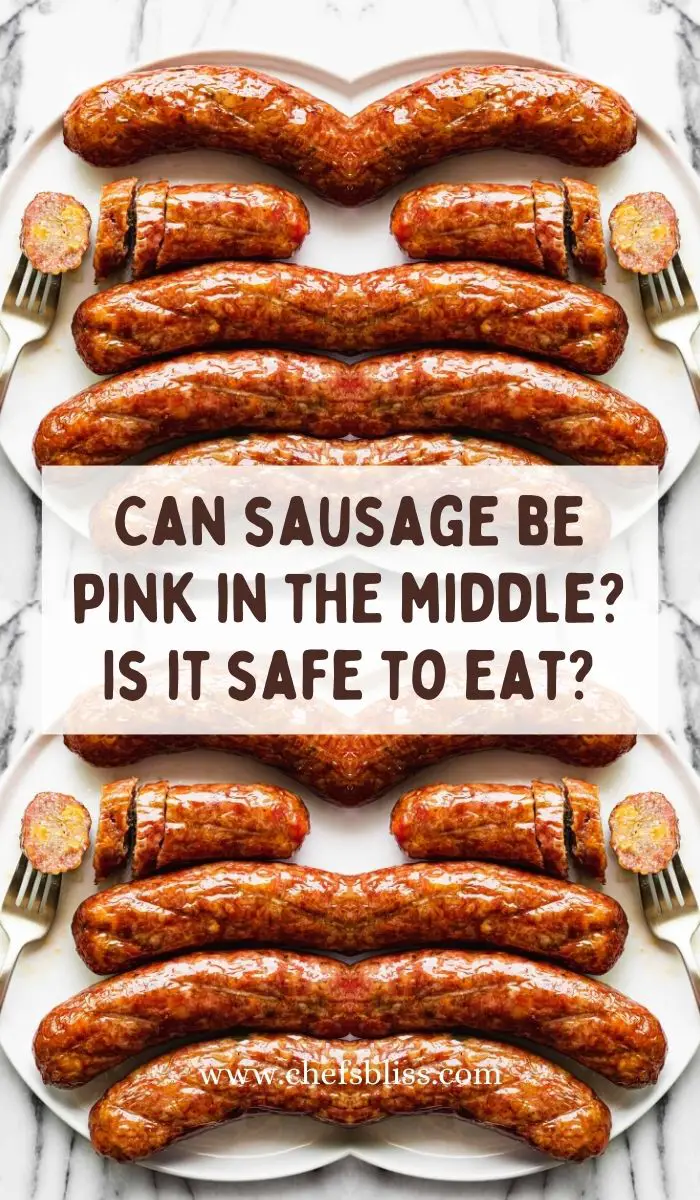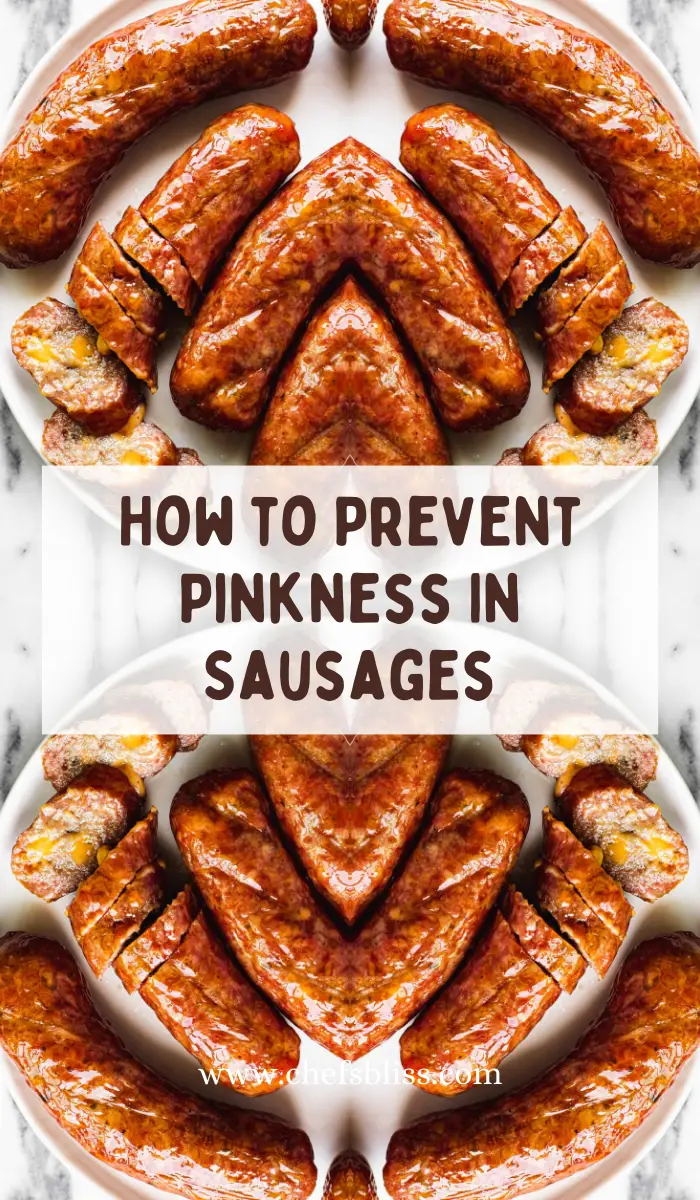Every product is independently reviewed and selected by our editors. If you buy something through our links, we may earn an affiliate commission at no extra cost to you.
If you’ve ever cooked sausages only to find them pink in the middle, you’re not alone. It can be a frustrating experience, leaving you questioning your culinary skills. Fear not!
In this article, we’ll explore the reasons behind sausages being pink in the middle, offer effective fixes, and provide tips on prevention.
Is it OK to eat sausage with a little pink in the middle?
In general, it is not recommended to eat sausage with any amount of pink in the middle unless it is a type of sausage that is intentionally cured or smoked, which can result in a pinkish color even when fully cooked. The pink color in these cases is considered safe.
Can sausage be pink in the middle?
Yes, it is possible for sausage to have a pink color in the middle, especially in certain circumstances.
However, the key factor to consider is whether the pink color is a result of proper cooking or if it indicates undercooking, which could pose a health risk.

can affect the color, and as long as the sausage reaches the recommended internal temperature, it is safe to eat.
On the other hand, if a sausage is pink in the middle due to undercooking, it is essential to address the issue promptly.
Undercooked sausages may harbor harmful bacteria, such as Salmonella or E. coli, which can lead to foodborne illnesses.
To ensure the safety of your sausages, use a meat thermometer to check the internal temperature.
The United States Department of Agriculture (USDA) recommends cooking sausages to an internal temperature of at least 160°F (71°C).
This ensures that any harmful bacteria are effectively eliminated, and the sausage is safe to consume.
Why does my sausage look pink in the middle?
Understanding these additional reasons can further guide you in achieving perfectly cooked sausages.

Remember to take into account the specific characteristics of the sausage you’re working with and adjust your cooking methods accordingly.
Undercooking:
One of the primary reasons for sausages being pink in the middle is undercooking.
Sausages need to be cooked thoroughly to ensure that harmful bacteria, such as Salmonella and E. coli, are eliminated.
Use a meat thermometer to check the internal temperature, which should reach at least 160°F (71°C).
Incorrect Cooking Time:
Cooking times can vary based on the type of sausage and cooking method. Failing to adhere to recommended cooking times can result in sausages being undercooked in the center. Always follow the guidelines provided on the packaging or in your recipe.
Frozen or Chilled Centers:
If you’re cooking sausages directly from the freezer or the center is still cold, it may not reach the desired temperature during cooking.
Allow sausages to thaw completely before cooking, and ensure they are at room temperature to promote even cooking.
Nitrite Reaction:
Some sausages contain nitrites, which are additives used to preserve color and prevent bacterial growth.
If the nitrites are not evenly distributed or if the sausage is cooked at high temperatures, it may result in a pinkish hue.
Ensure that you follow the recommended cooking instructions for nitrite-containing sausages.
Inadequate Mixing:
During the sausage-making process, inadequate mixing of ingredients, especially when incorporating curing agents or spices, can lead to uneven distribution.
This may result in portions of the sausage remaining pink even after cooking. Thoroughly mix the ingredients to ensure uniform color.
Type of Sausage:
Different types of sausages may have varying levels of pinkness, even when fully cooked.
For example, cured and smoked sausages may retain a pinkish hue due to the curing process.
Understanding the nature of the sausage you’re cooking is essential to avoid unnecessary concern.
Lean Meat Content:
Sausages made with lean meat, particularly poultry or game meats, might appear pinker than those made with fattier meats.
This is because lean meats have a different color profile, and even when fully cooked, they may retain a slightly pinkish tint.
Using a meat thermometer will help confirm whether the sausage is cooked to the recommended internal temperature.
Grilling Too Soon:
Placing sausages on a high-heat grill too soon can cause the outer layer to cook quickly, sealing in pinkness on the inside.
Allow the grill to preheat adequately before placing sausages on it, ensuring a more gradual and even cooking process.
How Can I Fix Sausage That Is Pink In The Middle?
There’s nothing worse than cutting into what should be a perfectly cooked sausage, only to find it’s pink in the middle.
But fear not, as we’ve got you covered with some quick and effective fixes to ensure your sausages are cooked to perfection every time.

Let’s dive into the solutions for turning those pink centers into savory delights.
Transfer to the Oven:
If you’ve pan-fried or grilled your sausages and notice they’re still pink in the middle, a simple solution is to transfer them to a preheated oven.
Place them on a baking sheet and bake at 350°F (175°C) for an additional 10-15 minutes, or until the internal temperature reaches the recommended 160°F (71°C).
This method allows for more even heat distribution, ensuring the center cooks through without burning the exterior.
Boil Before Cooking:
To expedite the cooking process and reduce the risk of undercooking, consider boiling your sausages briefly before finishing them on the grill or in a pan.
Boiling pre-cooks the sausages, giving you a head start on achieving that perfectly cooked result.
Once boiled, transfer them to the grill or pan for a final touch of flavor and texture.
Microwave Burst:
In a time crunch? Give your sausages a head start by microwaving them for a minute or two before cooking them on the stovetop or grill.
This jumpstart ensures the sausages begin cooking from the inside, reducing the risk of a pink center.
Just be cautious not to overdo it in the microwave, as you want to finish cooking with your preferred method for the best taste and texture.
Slice and Sear:
If you’re short on time and notice the pink center while cooking, slice the sausages lengthwise.
This exposes the interior, allowing for quicker and more even cooking. Sear the cut sides on a hot pan for a few minutes until they reach the desired internal temperature.
Finish Under a Broiler:
If oven space is limited, consider finishing your sausages under a broiler. This method provides intense heat from above, helping to brown the exterior while ensuring the center cooks thoroughly. Keep a close eye on them to prevent burning.
How to Prevent Pinkness In Sausages?
Preventing pinkness in sausages involves a combination of proper handling, cooking techniques, and understanding the characteristics of the sausage you are working with.

Here are some tips to help prevent pinkness in sausages:
Thaw Properly:
Ensure that sausages are properly thawed before cooking. Thaw them in the refrigerator rather than at room temperature or in the microwave. This helps promote even cooking and reduces the risk of a pink center.
Use a Meat Thermometer:
Invest in a reliable meat thermometer and use it to check the internal temperature of the sausages.
The recommended safe internal temperature for sausages is at least 160°F (71°C). This ensures that any harmful bacteria are eliminated, and the sausages are fully cooked.
Follow Cooking Guidelines:
Always follow the recommended cooking guidelines provided on the sausage packaging or in your recipe.
This includes both the cooking temperature and duration. Different types of sausages may have specific cooking requirements, so paying attention to these guidelines is crucial.
Precook or Parboil:
Consider precooking or parboiling sausages before grilling, pan-frying, or baking. This helps reduce the risk of undercooking and ensures that the sausages cook more evenly.
Once partially cooked, finish them using your preferred cooking method for added flavor and texture.
Avoid High Heat Initially:
When grilling sausages, avoid placing them directly over high heat right away. Start with medium heat to allow for more gradual cooking.
This helps prevent the outer layer from cooking too quickly while the inside remains pink.
Choose Cured or Precooked Sausages:
Opt for cured or precooked sausages, which are less likely to exhibit pinkness in the middle.
These sausages have undergone processes that contribute to their color, and they can be a safer option if you’re concerned about undercooking.
Slice and Check:
If you’re uncertain about the doneness of the sausages, you can slice one open to check the color.
If it appears pink in the middle, continue cooking until the sausages reach the recommended internal temperature.
Monitor Oven Temperature:
If baking sausages in the oven, be sure to monitor the temperature. An oven that is too hot can lead to uneven cooking. Adjust the temperature as needed to ensure consistent cooking throughout.
By following these tips and being attentive to the specific characteristics of the sausages you’re working with, you can significantly reduce the likelihood of encountering pinkness in the middle and enjoy fully cooked, safe, and delicious sausages.
What happens if you eat slightly pink sausage?
Consuming slightly pink sausage, especially if it’s fresh and hasn’t been cured or smoked, can pose a risk of foodborne illness.
The pink color in raw meats can be an indication that the meat has not been cooked to a safe internal temperature, allowing harmful bacteria to survive.

The primary concern with undercooked sausage is the potential presence of bacteria such as Salmonella, E. coli, or other pathogens.
These bacteria can cause foodborne illnesses, leading to symptoms such as nausea, vomiting, diarrhea, abdominal cramps, and, in severe cases, more serious complications.
To minimize the risk of foodborne illness, it’s essential to cook sausages thoroughly to the recommended internal temperature.
According to food safety guidelines, the minimum safe internal temperature for sausages is 160°F (71°C).
Using a meat thermometer is the most accurate way to ensure that the sausages have reached this safe temperature.
If you have consumed undercooked or slightly pink sausage and experience symptoms like nausea, vomiting, diarrhea, or abdominal pain, it’s crucial to seek medical attention promptly.
Foodborne illnesses can vary in severity, and some cases may require medical intervention to manage symptoms and prevent complications.
To prioritize food safety, always follow proper cooking guidelines, use a meat thermometer, and ensure that sausages reach the recommended internal temperature before consumption.
This approach helps protect against potential foodborne pathogens, ensuring that your meals are both delicious and safe to eat.
How can you tell if sausage is undercooked?
Determining if sausage is undercooked involves examining both the external and internal characteristics.

Here are some indicators that may suggest sausage is undercooked:
Color:
Undercooked sausages may retain a pinkish or raw appearance on the inside, even if the outer layer appears browned or cooked.
Fully cooked sausages should have a consistent color throughout, with no traces of pink or raw meat in the center.
Texture:
Undercooked sausages may have a softer and more rubbery texture compared to properly cooked sausages. Cooked sausages should have a firm and springy texture when pressed.
Juices:
Cut a small slit in the sausage, and if juices appear with a pinkish or reddish tint, it’s a sign that the sausage is undercooked. Fully cooked sausages should release clear juices.
Internal Temperature:
The most accurate way to determine if sausage is cooked is by using a meat thermometer.
Insert the thermometer into the thickest part of the sausage without touching the casing.
The internal temperature should reach at least 160°F (71°C) for pork or poultry sausages, ensuring that harmful bacteria are eliminated.
Casing Separation:
If the sausage casing starts to pull away from the meat, it may be an indication of undercooking. Properly cooked sausages should have intact casings.
Texture at the Center:
Gently press the center of the sausage. If it feels soft or squishy rather than firm, it may be undercooked. Fully cooked sausages should have a consistent texture throughout.
Visual Inspection:
Examine the interior of the sausage by cutting it open. If you notice any areas that are not fully cooked, such as pink or raw patches, it indicates undercooking.
What color should sausage be when cooked?
The color of cooked sausage can vary depending on factors such as the type of sausage, ingredients, and cooking methods.
However, as a general guideline, properly cooked sausages should have an internal color that is consistent and no longer pink.

Here are some general color expectations for various types of sausages:
Poultry Sausages:
Chicken or turkey sausages should have an internal color that is white and opaque when fully cooked. Ensure there is no pinkish tint in the center, and the juices should run clear.
Beef Sausages:
Beef sausages typically have a darker color compared to pork or poultry sausages. The internal color should be brown, and any pink or red tones should be absent. Juices should be clear.
Cured or Smoked Sausages:
Some sausages, like smoked or cured varieties, may have a pinkish hue even when fully cooked.
This is normal for certain cured meats, such as smoked sausages, ham, or kielbasa.
In these cases, the pink color is a result of the curing process and is considered safe to eat.
Regardless of the type of sausage, it’s essential to use a meat thermometer to verify that the internal temperature reaches at least 160°F (71°C).
This temperature ensures the elimination of harmful bacteria and confirms that the sausage is safe to eat.
When in doubt, follow the cooking instructions provided on the packaging or in your recipe, and use visual cues and a meat thermometer to achieve the desired color and doneness.
Conclusion
To sum up, the occurrence of sausage pink in the middle of sausages can be attributed to various factors such as improper blending of ingredients, inadequate cooking time, or the use of low-quality meats.
However, by following strict quality control measures, maintaining the correct cooking temperature, and using high-quality meat, this issue can be minimized or completely avoided.
Remember, proper handling and storage of sausages is essential for their overall quality and taste.
So, ensure you take the necessary precautions to prevent sausage pink in the middle.

